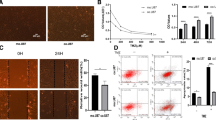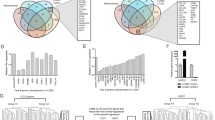Abstract
In recent years, it has been widely identified that the stromal cell-derived factor 1 (SDF-1) and anterior gradient 2 (AGR2) were implicated in the development of epithelial-mesenchymal transition (EMT) in a variety of cancers. However, the involvement of SDF-1-AGR2 pathway in the EMT of glioblastoma has not been investigated. In the present study, the in vitro assays were used to investigate the role of AGR2 in cell cycle, migration, and invasion. We found that the expressions of AGR2 and chemokine (C-X-C motif) receptor 4 (CXCR4) were obviously upregulated in glioblastoma cells T98G, A172, U87, and U251 than those in normal human astrocytes (NHA) (all p < 0.01), among which both U87 and U251 cells presented the highest expression (p > 0.05). Western blot revealed that SDF-1 induced the expression of p-AKT, AGR2, and EMT markers (N-cadherin, matrix metalloproteinase-2 (MMP2), and Slug) in a dose-dependent manner in U87 and U251 cells. However, the depletion of AGR2 reversed SDF-1-induced upregulation of EMT markers rather than p-AKT. Furthermore, functional analysis identified that knockdown of AGR2 induced cell cycle arrest in G0/G1 phase and suppressed the migration and invasion of U87 and U251 cells. Taken together, SDF-1-CXCR4 pathway induced the expression of AGR2 to control the progression of EMT likely via AKT pathway in the development of glioblastoma. Our findings lay a promising foundation for the SDF-1-AGR2 axis-targeting therapy in patients with glioblastoma.





Similar content being viewed by others
References
Kirkpatrick JP, Sampson JH. Recurrent malignant gliomas. Semin Radiat Oncol. 2014;24:289–98.
Young RM, Jamshidi A, Davis G, et al. Current trends in the surgical management and treatment of adult glioblastoma. Ann Transl Med. 2015;3:121.
Wilson TA, Karajannis MA, Harter DH. Glioblastoma multiforme: state of the art and future therapeutics. Surg Neurol Int. 2014;5:64.
Weathers SP, Gilbert MR. Advances in treating glioblastoma. F1000Prime Rep. 2014;6:46.
Lv B, Yang X, Lv S, Wang L, et al. CXCR4 signaling induced epithelial-mesenchymal transition by PI3K/AKT and ERK pathways in glioblastoma. Mol Neurobiol. 2015;52(3):1263–8.
Dai C, Lv S, Shi R, et al. Nuclear protein C23 on the cell surface plays an important role in activation of CXCR4 signaling in glioblastoma. Mol Neurobiol. 2015;52(3):1521–6.
Ehling J, Tacke F. Role of chemokine pathways in hepatobiliary cancer. Cancer Lett. 2015. doi:10.1016/j.canlet.2015.06.017.
Stoicov C, Li H, Liu JH, et al. Mesenchymal stem cells utilize CXCR4-SDF-1 signaling for acute, but not chronic, trafficking to gastric mucosal inflammation. Dig Dis Sci. 2013;58:2466–77.
Kuang WW, Thompson DA, Hoch RV, et al. Diferential screening and suppression subtractive hybridization identified genes differentially expressed in an estrogen receptor-positive breast carcinoma cell line. Nucleic Acids Res. 1998;26:1116–23.
Thompson DA, Weigel RJ. hAG-2, the human homologue of the Xenopus laevis cement gland gene XAG-2, is coexpressed with estrogen receptor in breast cancer cell lines. Biochem Biophys Res Commun. 1998;251:111–6.
Fletcher GC, Patel S, Tyson K, et al. hAG-2 and hAG-3, human homologues of genes involved in differentiation, are associated with oestrogen receptor-positive breast tumours and interact with metastasis gene C4.4a and dystroglycan. Br J Cancer. 2003;88:579–85.
Niu H, Zhang X, Wang B, et al. The clinical utility of RFA in esophageal and cardia cancer patients with severe malignant obstruction. Tumour Biol. 2015. doi:10.1007/s13277-015-3925-x
Lv S, Sun B, Zhong X, et al. The clinical implications of chemokine receptor CXCR4 in grade and prognosis of glioma patients: a meta-analysis. Mol Neurobiol. 2015;52(1):555–61.
Tidball JG, Welc SS. Macrophage-derived IGF-1 is a potent coordinator of myogenesis and inflammation in regenerating muscle. Mol Ther. 2015;23:1134–5.
Du J, Li B, Fang Y, et al. Overexpression of class III β-tubulin, Sox2, and nuclear survivin is predictive of taxane resistance in patients with stage III ovarian epithelial cancer. BMC Cancer. 2015;15:536.
Ramakrishna R, Pisapia D. Recent molecular advances in our understanding of glioma. Cureus. 2015;7:e287.
Bhuvanalakshmi G, Arfuso F, Millward M, et al. Secreted frizzled-related protein 4 inhibits glioma stem-like cells by reversing epithelial to mesenchymal transition, inducing apoptosis and decreasing cancer stem cell properties. PLoS One. 2015;10:e0127517.
Zhang B, Shi L, Lu S, et al. Autocrine IL-8 promotes F-actin polymerization and mediate mesenchymal transition via ELMO1-NF-κB-Snail signaling in glioma. Cancer Biol Ther. 2015;16:898–911.
Palena C, Hamilton DH, Fernando RI. Influence of IL-8 on the epithelial-mesenchymal transition and the tumor microenvironment. Future Oncol. 2012;8:713–22.
Pan Y, Zhang Y, Chen L, et al. The critical role of Rab31 in cell proliferation and apoptosis in cancer progression. Mol Neurobiol. 2015. doi:10.1007/s12035-015-9378-9
Kim YS, Joh TH. Matrix metalloproteinases, new insights into the understanding of neurodegenerative disorders. Biomol Ther (Seoul). 2012;20:133–43.
Yan J, Zhang Y, Shi W, et al. The critical role of HMGA2 in regulation of EMT in epithelial ovarian carcinomas. Tumour Biol. 2015. doi:10.1007/s13277-015-3852-x
Yang X, Lv S, Liu Y, et al. The clinical utility of matrix metalloproteinase 9 in evaluating pathological grade and prognosis of glioma patients: a meta-analysis. Mol Neurobiol. 2015;52(1):38–44.
Acknowledgments
Conceived and designed the experiments: Erming Zeng and Chunhua Xu. Performed the experiments: Chunhua Xu, Yue Liu, Limin Xiao, and Changgui Guo. Analyzed the data: Shengze Deng and Suyue Zheng. Wrote the paper: Erming Zeng and Chunhua Xu.
Author information
Authors and Affiliations
Corresponding author
Ethics declarations
Conflicts of interest
None
Rights and permissions
About this article
Cite this article
Xu, C., Liu, Y., Xiao, L. et al. The involvement of anterior gradient 2 in the stromal cell-derived factor 1-induced epithelial-mesenchymal transition of glioblastoma. Tumor Biol. 37, 6091–6097 (2016). https://doi.org/10.1007/s13277-015-4481-0
Received:
Accepted:
Published:
Issue Date:
DOI: https://doi.org/10.1007/s13277-015-4481-0




